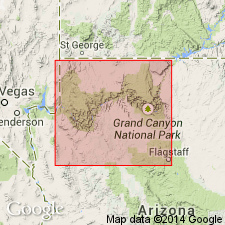
- Usage in publication:
-
- Tincanebits tongue
- Modifications:
-
- Original reference
- Dominant lithology:
-
- Limestone
- Dolomite
- AAPG geologic province:
-
- Plateau sedimentary province
Summary:
"It is confusing, from McKee's text and fig. 1 whether the tongue is assigned to the Muav formation or to the Bright Angel shale" (GNC note, n.d.). Tincanebits tongue [of Bright Angel shale of Tonto group] (USGS Bull. 1200); Tincanebits tongue [of Bright Angel shale of Tonto group] (USGS DDS-6).
Pg. 14 (fig. 1), 29, 80-82. Rusty-brown dolomite tongue in Bright Angel shale of western Grand Canyon. Thickness ranges from 8.5 to 30 feet. Separated from underlying red-brown cliff-forming unit of Bright Angel by 30 to 100 feet of micaceous green shale and thin-bedded brown siltstone. Interfingers with Muav limestone. Lateral equivalent of certain limestone beds found in area west of Grand Canyon that probably constitute a member of the Muav, which is lower than any member within the Grand Canyon. Older than Meriwitica tongue (new). No fossils found. [On p. 29 age stated to be Early and Middle Cambrian and on p. 184 (part 2) Middle Cambrian. Age is considered Early and(or) Middle Cambrian.] Report includes cross sections, measured sections.
Type locality not designated. Is lower of two rusty-brown dolomite units in the western Grand Canyon [Coconino and Mohave Cos., northwestern AZ]. Traced along walls of canyon for many miles. Origin of name not stated by author, but probably named from Tincanebits Wash, north of Colorado River and north of Lake Meade, Mohave Co., northwestern AZ.
Source: US geologic names lexicon (USGS Bull. 1200, p. 3893); supplemental information from GNU records (USGS DDS-6; Menlo GNULEX, Denver GNULEX), GNC index card files.

- Usage in publication:
-
- Tincanebits Tongue*
- Modifications:
-
- Adopted
- Age modified
- AAPG geologic province:
-
- Plateau sedimentary province
Summary:
Tincanebits Tongue of McKee (1945) adopted as lowermost of three named units of Bright Angel Shale. Underlies Meriwitica Tongue of Bright Angel and intertongues with Muav Limestone. Age is Middle Cambrian.
Source: GNU records (USGS DDS-6; Menlo GNULEX).
For more information, please contact Nancy Stamm, Geologic Names Committee Secretary.
Asterisk (*) indicates published by U.S. Geological Survey authors.
"No current usage" (†) implies that a name has been abandoned or has fallen into disuse. Former usage and, if known, replacement name given in parentheses ( ).
Slash (/) indicates name conflicts with nomenclatural guidelines (CSN, 1933; ACSN, 1961, 1970; NACSN, 1983, 2005, 2021). May be explained within brackets ([ ]).

